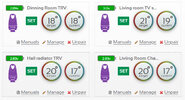3. I understand that the room with the thermostat cannot have a TRV in it. However, which room should the thermostat go in?
I cannot work out whether it should go in the room that needs to be kept the warmest (and most often used) or should it in fact go in the coldest room in the house.
The idea is to put it where it will be on the most, the TRV will stop a room over heating, but can't stop a room under heating, also when summer arrives nice to have heating auto stop, so being in a cool room means heating less likely to run on a warm day. The other points is should not be in a room with alternative heating, like a kitchen, or a room with large windows so heated with the sun, and also not in a room with outside doors, following the above rules no room satisfies the criteria so intend to fit a second wall thermostat in parallel with first, and will have TRV's in room with thermostat.
2. Do rooms with 2 TRVs need to be on the exact same number? Again, I think they probably do.
I used cheap eQ-3 TRV heads with bluetooth cost me £15 each in 2019, and they can pair together so both radiators work as a pair, however found that electronic heads work better anyway, so no real need to pair them.
1. Do you put a TRV in a bathroom? I assume not as quick fluctuations in heat (from bath/shower) will mess it up.
The shower room/toilet is the only room in main house to have a non programmable TRV head, the bathroom does not have a TRV but this is because the towel rail is thermo syphon and acts as a by-pass for the boiler to cool.
But it depends so much on the home, first house hot air so does not count, second open plan, had TRV's to stop bedroom over heating, but down stairs one wall thermostat did all.
Mother house was first where we had a problem, mainly due to bay windows heating living room too fast, so was the first house where we used Energenie TRV heads, the main advantage was easy to set the lock shield valves,

they show target and current, clearly current should not exceed target, so if it did the lock shield closed a bit, new owners did not want them, so put old mechanical back, and once the lock shields were set, the old mechanical worked A1, however how do you know what temperature the TRV is set at when it just says *123456 ? needed TRV in degrees C to set lock shield in first place.
This house two faulty Energenie made into one good one, so three of the old Energenie still working, five eQ-3 with bluetooth and one Kasa (TP-Link) to replace the damaged Energenie, non linked to the Nest Gen 3 wall thermostat (load of rubbish) and 5 mechanical still in used, 4 in the flat under the house, which can be isolated with motorised valves. Just fitted new double glazing and waiting to see how it all works before buying second wall thermostat.
The dinning room is at moment not used, as is the office, so those two TRV's turned off, the craft room turned on when required, the bedrooms only turn on at 10 pm, and the living room turns off at midnight and back on at 8 am, I say off, really turns down to eco setting. The main wall thermostat turns to comfort at 8 am and to Eco at 12:30 am.
That I see as a problem if using hall way for the wall thermostat, what I want is when hall door opened, the TRV's detect the cold blast of air and turn off for 15 minutes I have set as window open inhibit, so can unload car without heating street, then the TRV will fully open to reheat hall, but at 17ºC it starts to close again so as not to over heat hall and cause other rooms to get cold, and the wall thermostat is set to 20ºC and being higher up on the wall it will turn off the boiler as the house heats up.
Heating bit is easy, it is the cooling where it all falls over, the hall was cooling faster than the living room, so living room would get cold before heating turned on again, hence considering second thermostat in living room. The Nest Gen 3 also does timed DHW, that bit is OK, so second will only do room temperature. They all need to be either battery powered, or from same FCU as the boiler, so with a power cut heating will continue to work from the battery back up and solar panels. Flat is hit and miss, don't use it in winter so not worried about it.
I will admit the TRV's in this house with a simple on/off boiler don't work as well as they did in mothers house with a modulating boiler, with a modulating boiler everything works analogue, turning boiler up/down, turning TRV's up/down, nothing turns on/off except the on/off timer. So her radiators were in the main warm, never hot or cold, this house with oil, radiators get hot and cold so a larger hysteresis in temperature.
In 2019 when I first set my house up, at £15 each could not see point in not having programmable TRV heads.



